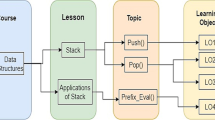Abstract
This paper presents a system to recommend a learning path to an e-learner of a virtual university according to the assessment of linear combination of learner specific parameters and system specific parameters. An online virtual university offers various courses. But learners of this university often face problems due to several constraints of the course. Online recommendation of learning path is an important research issue for virtual learning systems because no fixed learning path will be appropriate for all learners. Generally, inappropriate courseware leads a learner to cognitive overload or disorientation during learning processes, thus it results in reducing learning performance. The developed system implements a simple approach to recommend a learning path to guide a learner from any point of the course. Experimental result also supports the system by manifesting desired output.
Access this chapter
Tax calculation will be finalised at checkout
Purchases are for personal use only
Preview
Unable to display preview. Download preview PDF.
Similar content being viewed by others
References
Tinio, V.L.: ICT in Education. e-primers for the information economy, society and polity, e-Asean Task Force and UNDP-APDIP, http://www.eprimers.org/~ict/~page25.asp
Willis, J.W., Johnson, D.L., Dixon, P.N.: Computers, Teaching and Learning: An Introduction to Computers in Education. Dilithium Press (1983, 2001)
Kennewell, S.: Using Affordances and Constraints to Evaluate the use of Information Technology in Teaching and Learning. J. of Information Technology for Teacher Education 10(1 and 2), 101–116
Sleeman, D.J., Brown, J. (eds.): Introduction: Intelligent Tutoring System, in Intelligent Tutoring systems, pp. 1–11. Academic Press (1982)
Connolly, T.M., MacArthur, E., Stansfield, M.H., McLellan, E.: A quasi-experimental study of three online learning courses in computing. Computers and Education 49, 345–359 (2007)
Gunawardena, C.N., McIsaac, M.S.: Distance education. In: Jonassen, D.H. (ed.) Handbook of Research for Educational Communications and Technology, 2nd edn., pp. 355–396. LEA, Mahwah (2004)
The university: current challenges and opportunities Robin Mason. The Virtual University: Models and Messages Lessons from Case Studies, UNESCO 2006, pp. 49-70, ISBN 978-92-3-104026-9
Naidoo, V.: The changing venues for learning. In: Farrell, G. (ed.) The Changing Faces of Virtual Education, pp. 11–28. The Commonwealth of Learning, Vancouver (2001)
Sagna, O.: Les technologies de linformation et de la communication et le dveloppement social au Sngal: un tat des lieux. Paper PP TBS 1. Geneva: United Nations Research Institute for Social Development, Technology and Society Programme, pp. 13 (2001)
Van Dusen, W.D., et al.: A Manual for Conducting Student Attrition Studies, National Center for Higher Education Management Systems (1979)
Chen, C.-M., Peng, C.-J.: Personalized E-learning System based on Ontology-based Concept Map Generation Scheme. In: Seventh IEEE International Conference on Advanced Learning Technologies (ICALT 2007) (2007)
Hong, C.-M., Chen, C.-M., Chang, M.-H., Chen, S.-C.: Intelligent Web-based Tutoring system with Personalized Learning Path Guidance. In: 7th International Conference on Advanced Learning Technologies, ICALT 2007 (2007)
Marquez, J.M., Ortega, J.A., Gonzalez-Abril, L., Velasco, F.: Creating adaptive learning paths using Ant Colony Optimization and Bayesian Networks
Gascuena, J.M., Caballero, A.F., Gonzalez, P.: Domain Ontology for Personalized E- Learning in Educational Systems. In: Sixth IEEE International Conference on Advanced Learning Technologies , ICALT 2006 (2006)
de Marcos, L., Pages, C., Martnez, J.J., Gutierrez, J.A.L.: Competency-based Learning Object Sequencing using Particle Swarms. In: 19th IEEE International Conference on Tools with Artificial Intelligence (2007)
Chang, M., Chang, A., Heh, J.-S., Liu, T.-C.: Contextaware Learning Path planner 7(4) (April 2008)
Huang, M.-J., Huang, H.-S., Chen, M.-Y.: Constructing a personalized e-learning system based on genetic algorithm and casebased reasoning approach. Expert Systems with Applications 33, 551–564 (2007)
Anh, N.V., Ha, N.V., Dam, H.S.: Constructinga Bayesian Belief Network to Generate Learning Path in Adaptive Hypermedia System T.24, S.1 (2008)
Karampiperis, P., Sampson., D.: Adaptive Learning Resources Sequencing in Educational Hypermedia Systems. Educational Technologies and Society 8(40), 128–147
Gao, S., Zhang, Z.I., Hawryszkiewycz, I.: Supporting Adaptive Learning in Hypertext Environment: A High Level Timed Petri Net Based Approach. In: 5th IEEE International Conference on Advanced Learning Technologies 2005, pp. 735–739 (2005)
Carchiolo, V., Longheu, A., Malgeri, M., Mangioni, G.: Automatic generation of learning paths. In: Proceedings of the 10th International Conference IEEE on Electronic, Circuits and Systems, vol. 3, pp. 1236–1239 (2003)
Lin, W.H., Shih, T.K., Chang, W.-C., Yang, C.-H.: A Petri Nets-based Approach to Modeling SCORM Sequence. In: IEEE International Conference on Multimedia and Expo, ICME 2004, vol. 2, pp. 1247–1250 (2004)
Yang, Y.J., Wu, C.: An attributes based ant colony system for adaptive learning object recommendation. Expert Systems with Application 36, 3034–3047 (2009)
Zhang, T.: Adaptive Forward-Backward Greedy Algorithm for Sparse Learning with Linear Models. IEEE Transactions on Information Theory 57(7), 4689–4708
Tropp., J.A.: Greed is good: Algorithmic results for sparse approximation. IEEE Trans. Info. Theory 50(10), 2231–2242 (2004)
Author information
Authors and Affiliations
Editor information
Editors and Affiliations
Rights and permissions
Copyright information
© 2013 Springer-Verlag Berlin Heidelberg
About this paper
Cite this paper
Basu, P., Bhattacharya, S., Roy, S. (2013). Online Recommendation of Learning Path for an E-Learner under Virtual University. In: Hota, C., Srimani, P.K. (eds) Distributed Computing and Internet Technology. ICDCIT 2013. Lecture Notes in Computer Science, vol 7753. Springer, Berlin, Heidelberg. https://doi.org/10.1007/978-3-642-36071-8_9
Download citation
DOI: https://doi.org/10.1007/978-3-642-36071-8_9
Publisher Name: Springer, Berlin, Heidelberg
Print ISBN: 978-3-642-36070-1
Online ISBN: 978-3-642-36071-8
eBook Packages: Computer ScienceComputer Science (R0)




